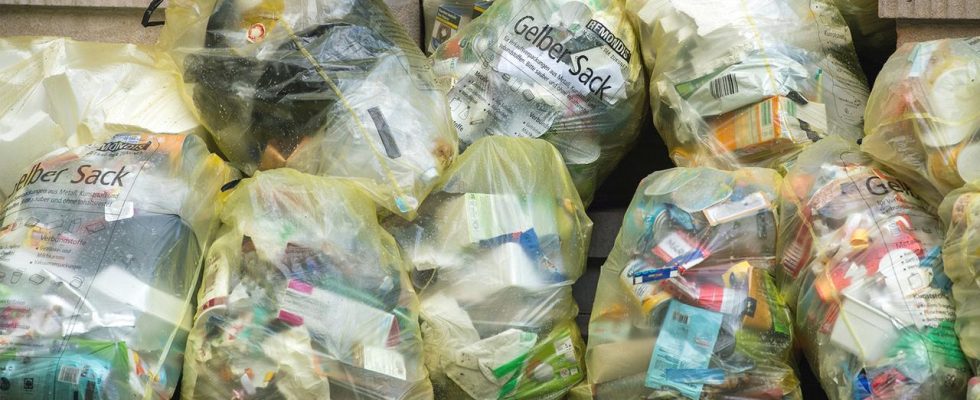Researchers have discovered new microorganisms in the Arctic and the Alps that can decompose plastic – even at low temperatures. But is that enough for an industrial application?
Every year, more than six million tons of plastic waste are generated in Germany. This is a problem, because part of it ends up in the environment, in the soil or in the rivers and seas – with some serious problems for the ecosystems.
Decomposes at room temperature
A research team from Switzerland has therefore researched which microorganisms, i.e. bacteria, are able to decompose plastic – and made an interesting discovery: They were able to identify several strains of bacteria that already decompose certain plastics even at lower temperatures of around 15 degrees Celsius can, so the result of their study.
Organisms that can “eat” plastic have been known for some time – “but these were typically tested at over 30 degrees Celsius,” says first author Joel Rüthi. According to the authors, decomposition at room temperature could reduce energy consumption in a potential industrial application.
Discovered in the Arctic
The researchers found the microorganisms in the Alps and the Arctic. They sometimes buried pieces of plastic for a year and then looked at which organisms had settled on them. They discovered 19 bacterial strains and 15 fungal strains on the plastic. “Some of these bacteria and fungi are previously unknown species,” says Rüthi.
In the laboratory, they then examined which types of plastic they could decompose. In the case of the substances polyester-polyurethane (PUR), polybutylene adipate terephthalate (PBAT) and polylactide (PLA), two types of fungi in particular achieved good results. However, they cannot do this with one of the most common plastics, polyethylene terephthalate (PET).
These are the main types of plastic
According to the OECD, around 460 million tons of plastic are produced worldwide every year. The most important raw material for this is crude oil. And the demand continues to rise: According to various estimates, the quantity is likely to double by 2050.
PET (Polyethylene terephthalate): Used for disposable and returnable bottles, food packaging and as polyester in textiles. The amount of world production is more than 30 million tons.
pp (Polypropylene): Found in car interior trim, food packaging or bicycle helmets. About 70 million tons are produced worldwide.
PE (Polyethylene): Is the most common plastic: the world production is more than 100 million tons. It is used, for example, for packaging, garbage bags or cable insulation.
PURE (Polyurethane): Found in mattresses, sports shoes or construction foam. About 25 million tons of it are produced.
PBAT, PTA: These and other bioplastics account for only about two percent of global plastic production.
The discovery of the Swiss researchers is also still in the early stages. “Next, we need to identify the enzymes that are produced by the microorganisms,” said Rüthi. These would then probably have to be optimized, for example to make them more stable and durable.
“Most promising Technology”
The goal would probably be to turn it into an application for industry. A lot of research is currently being done on this – on so-called enzymatic recycling – explains Uwe Bornscheuer from the University of Greifswald. “We have an enormous problem with plastic waste and this technology is the most promising to counter it,” says the chemist.
In France, a plant is already being planned in which around 50,000 tons of PET plastic will be decomposed using a special enzyme from 2025. “Especially for private companies, the costs play a major role. And if you can work at room temperature instead of at 50 or 70 degrees, that’s of course a huge advantage,” says Bornscheuer. However, it remains to be seen whether the processes will still be fast enough and whether the quality of the end products will be the same.
The aim is to break down the polymers into monomers with the help of the microorganisms – which produce the enzymes – or directly with certain enzymes. This can then be used to produce new plastics – a circular economy.
Small amounts as a problem
However, the microbiologist Wolfgang Zimmermann from the University of Leipzig points to a limitation of the Swiss discovery – at least for the moment: “These microorganisms work particularly well with easily degradable plastics, which in terms of quantity make up a rather small proportion of the entire production.”
Therefore, the low-temperature bacteria are currently not a game changer. However, according to Zimmermann, the trend is increasingly “moving from hard-to-recycle to more easily degradable plastics. In the future, there could be more demand for easily degradable polymers – which could make the organisms described interesting again.”
With an enzyme cocktail against plastic
In addition, mixtures of different enzymes are being sought for polyurethane degradation, for example. Every further discovery could make a contribution to this. A process with several enzymes is also well suited for food packaging, which usually consists of several types of plastic. Because this packaging cannot currently be processed with conventional recycling methods and is therefore usually incinerated.
All in all, both researchers see enormous potential in “plastic-eating bacteria”: “We will see a lot of development in the coming years, also on an industrial scale,” believes Bornscheuer. However, an important prerequisite is good waste separation so that the various plastics can be recycled in a targeted manner; the consumers are also asked here.
Zimmermann agrees. He also points out that the oil price will increase in the long term, making the enzymatic recycling of plastics relatively more profitable. In addition, a rethink is underway: “People and politicians are becoming more and more aware of the plastic problem. That’s why we should pursue every possible solution.”

